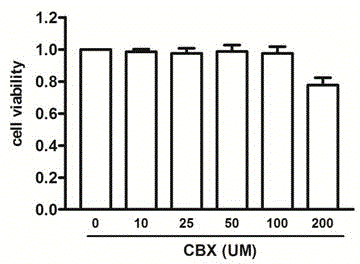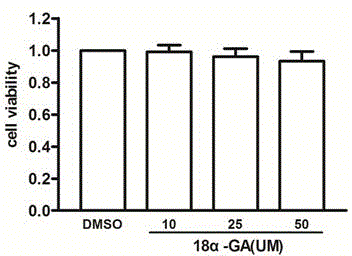Application of carbenoxolone in preparing anti-dengue virus medicine
A technology of dengue virus and carbenoxic acid, applied in antiviral agents, resistance to vector-borne diseases, and pharmaceutical formulations, can solve the problems that endanger the lives and health of people in tropical and subtropical regions, and have not developed anti-dengue virus drugs and vaccines, Lack of effective animal models and other issues, to achieve huge social benefits and research value, good application prospects, and easy access to the effect
- Summary
- Abstract
- Description
- Claims
- Application Information
AI Technical Summary
Problems solved by technology
Method used
Image
Examples
Embodiment 1
[0034] Toxicity test of carbenoxic acid on A549 cells:
[0035] The carbenoxic acid used in the present invention was purchased from Sigma (C4790-1G).
[0036] Toxicity test
[0037] 1. Inoculation of A549 cells: use DMEM medium containing 5% fetal bovine serum to prepare a single cell suspension, inoculate 2000-3000 cells per well into 96-well cell culture plates, and inoculate volume of 100ul per well;
[0038] 2. Cultivate A549 cells: culture for 1 day at 37°C, 5% CO2;
[0039] 3. Add carbenoxol: suck out the DMEM medium in each well, add 100ul carbenoxol diluted with DMEM medium containing 5% fetal bovine serum to the corresponding concentration (10UM, 25UM, 50UM, 100UM, 200UM) to each well Peric acid, control well plus 100ul of DMEM medium containing 5% fetal bovine serum without drugs;
[0040] 4. Color: After 24 hours of culture, add 10ul of MTT solution to each well, continue to incubate for 4 hours at 37°C, 5% CO2 culture conditions, then terminate the culture, d...
Embodiment 2
[0047] Toxicity test of 18α glycyrrhetinic acid on A549 cells:
[0048] The 18α glycyrrhetinic acid used in the present invention was purchased from Sigma (G8503-250MG).
[0049] Toxicity test
[0050] 1. Inoculation of A549 cells: use DMEM medium containing 5% fetal bovine serum to prepare a single cell suspension, inoculate 2000-3000 cells per well into 96-well cell culture plates, and inoculate volume of 100ul per well;
[0051] 2. Cultivate A549 cells: culture for 1 day at 37°C, 5% CO2;
[0052] 3. Add 18α glycyrrhetinic acid: discard the DMEM medium in each well, add 100ul of 18α glycyrrhetinic acid diluted to the corresponding concentration (10UM, 25UM, 50UM) with DMEM medium containing 5% fetal bovine serum to each well 100ul of DMEM medium containing 5% fetal bovine serum without drugs was added to the control well;
[0053] 4. Color: After 24 hours of culture, add 10ul of MTT solution to each well, continue to incubate for 4 hours at 37°C, 5% CO2 culture condit...
Embodiment 3
[0060] Inhibitory effect of carbenoxic acid on DENV2:
[0061] DENV2 MOI=1 to infect A549 cells, the experimental steps are as follows:
[0062] 1. Planting cells: Inoculate A549 cells in a 24-well cell culture plate. After 24 hours, the cells grow to a monolayer (the area of the cell covering the bottom of the well is about 80-90%). Aspirate the medium, insert 100ul of virus samples, and adsorb at 37°C 1 hour. After the adsorption is completed, the virus liquid in each well is discarded, and the unadsorbed virus is washed away with DMEM medium. Add carbenoxacin at specified concentrations (10UM, 25UM, 50UM, 100UM) diluted with DMEM medium containing 5% fetal bovine serum, and store at 37°C in 5% CO 2 Incubate in an incubator for 24 hours, collect the supernatant in each well, and then detect the virus titer according to TCID50.
[0063] Table 3 different concentrations of carbenoxic acid on DENV2 titer reduction experiment
[0064]
[0065] 2. TCID50 experiment:
...
PUM
 Login to View More
Login to View More Abstract
Description
Claims
Application Information
 Login to View More
Login to View More - R&D
- Intellectual Property
- Life Sciences
- Materials
- Tech Scout
- Unparalleled Data Quality
- Higher Quality Content
- 60% Fewer Hallucinations
Browse by: Latest US Patents, China's latest patents, Technical Efficacy Thesaurus, Application Domain, Technology Topic, Popular Technical Reports.
© 2025 PatSnap. All rights reserved.Legal|Privacy policy|Modern Slavery Act Transparency Statement|Sitemap|About US| Contact US: help@patsnap.com



